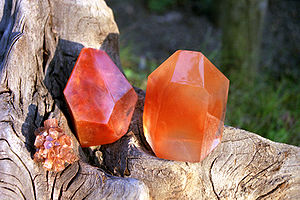红玉髓
| 红玉髓 | |
|---|---|
 | |
| 基本资料 | |
| 类别 | 玉髓的变种 |
| 化学式 | 二氧化硅 (SiO2) |
| 性质 | |
| 分子量 | 60 g/mol |
| 颜色 | 棕红色 |
| 晶系 | 三方晶系 |
| 解理 | 无 |
| 断口 | 不均匀,碎裂,贝壳状 |
| 莫氏硬度 | 6 - 7 |
| 光泽 | 玻璃质、暗沉、油腻、柔滑 |
| 条痕 | 白色 |
| 透明性 | 半透明 |
| 比重 | 2.59 - 2.61 |
| 参考文献 | [1] |
红玉髓,是一种棕红色的二氧化硅为主要组成成分的矿物,常被用作为一种装饰性宝石,也可以被雕刻成各种工艺品。
红玉髓属于玉髓的一种变体,因掺杂氧化铁而显色,红玉髓的颜色多样,色泽最亮的显橙白色,而最暗的接近黑色。红玉髓最常见的产地为巴西、印度、德国和俄罗斯西伯利亚。
语源
[编辑]
在中文中“红玉髓”也可以叫作红石髓和赤珠。
在英文里,中文的红玉髓有两种含义,一种是指颜色较浅的光玉髓(英语:carnelian/cornelian)[2],另一种是指色暗且质地较硬的褐红玉髓(英语:sard)。[3][4]
英语中的"carnelian"源自14世纪的单词"cornelian",于16世纪误写为carnelian.[5] Cornelian与罗曼语族的其他一些单词同源,来自中世纪拉丁语的corneolus,可进一步上溯至拉丁语的cornum(大果山茱萸)[6] 。大果山茱萸的透亮红色果实与光玉髓相似。 牛津英语词典认为"carnelian" 是 "cornelian"的变种,来自拉丁语的caro, carnis(肉)。老普林尼认为sard一词来自吕底亚的萨第斯(Sardis),褐红玉髓的产地;而其他人认为这一词最终可追溯到波斯语的سرد (sered),意为红黄色。
历史
[编辑]早在新石器时代早期的保加利亚,红色的玉髓就被用做宝珠。最早有打磨晶面的红玉髓出自保加利亚的瓦尔纳古墓,可上溯至公元前5千年中期。宝珠两侧各有16个打磨面,合计32个打磨面。[7]公元前5000-4000年的梅赫尔格尔遗迹中出土了有钻孔的红玉髓。[8]克里特岛上克诺索斯的米诺斯青铜文明层中发现了公元前1800年的红玉髓,其形制表明曾用作装饰。[9]在罗马时代,红玉髓被广泛用于制作宝石像;又因为红玉髓不沾蜡油,还被用来制作蜡封用的印章。[10]褐红玉髓被用作亚述的滚筒印章、古埃及和腓尼基的圣甲虫、以及古希腊和伊特拉斯坎的珠宝。[11], 犹太大祭司的胸牌上的第一块宝石(被称作odem或sardius)是一块红色宝石,很有可能是褐红玉髓,也有可能是红色的碧玉。[11]在启示录4:3中, 使徒约翰描述天上的宝座上坐着的"好像碧玉和红宝石",其中"红宝石"即为 sardius. 同一种“红宝石”还出现在启示录21:20中,是圣城城墙根基上的十二种宝石之一。[12]

光玉髓和褐红玉髓的区别
[编辑]红玉髓有时指光玉髓、有时指褐红玉髓;在英文中carnelian和sard也时常混用。通常而言,光玉髓和褐红玉髓有如下区别:
| 光玉髓(Carnelian) | 褐红玉髓(Sard) | |
|---|---|---|
| 颜色 | 较浅,色泽呈浅橙色到红棕色 | 较深,色泽呈深红棕色至近黑色。 |
| 硬度 | 较软 | 较坚硬 |
| 断口 | 不均匀,碎裂,呈贝壳状 | 与光玉髓相近,但更暗且呈锯齿状 |
上述性质是连续变化的,因此光玉髓与褐红玉髓之间没有明确的界限。
参见
[编辑]参考文献
[编辑]- ^ Rudolf Duda and Lubos Rejl: Minerals of the World (Arch Css, 1990)
- ^ Websters New World College Dictionary. Fourth Edition. 2001. Editor in chief Michael Agnes.
- ^ 实现自我 稳定情绪:绿玉髓 - 大纪元. 大纪元 www.epochtimes.com. 2011-05-10 [2018-11-19]. (原始内容存档于2019-12-03) (中文(中国大陆)).
- ^ 陆, 启萍. 寶石101問,我的第一本珠寶書 第一版. 台北市. 2011: 44. ISBN 9789861216485. OCLC 761226702.
- ^ 'Cornelian'. Oxford English Dictionary. Oxford University Press. [14 February 2012]. (原始内容存档于2008-01-11).
- ^ Chisholm, Hugh (编). Carnelian. Encyclopædia Britannica (第11版). London: Cambridge University Press. 1911.
- ^ Kostov, Pelevina, 2008
- ^ Kulke, Hermann & Rothermund, Dietmar (2004). A History of India. Routledge. 22.
- ^ C. Michael Hogan, Knossos fieldnotes, Modern Antiquarian (2007) (页面存档备份,存于互联网档案馆)
- ^ Section 12 of the translation of Weilue - a 3rd-century Chinese text by John Hill under "carnelian" and note 12.12 (17)
- ^ 11.0 11.1 Chisholm, Hugh (编). Sard. Encyclopædia Britannica (第11版). London: Cambridge University Press. 1911.
- ^ Revelation 4:3
扩展阅读
[编辑]- Allchin, B. 1979. The agate and carnelian industry of Western India and Pakistan. – In: South Asian Archaeology 1975. E. J. Brill, Leiden, 91-105.
- Beck, H. C. 1933. Etched carnelian beads. – The Antiquaries Journal, 13, 4, 384-398.
- Bellina, B. 2003. Beads, social change and interaction between India and South-east Asia. – Antiquity, 77, 296, 285-297.
- Brunet, O. 2009. Bronze and Iron Age carnelian bead production in the UAE and Armenia: new perspectives. – Proceedings of the Seminar for Arabian Studies, 39, 57-68.
- Carter, A. K., L. Dussubieux. 2016. Geologic provenience analysis of agate and carnelian beads using laser ablation-inductively coupled plasma-mass spectrometry (LA-ICP-MS): A case study from Iron Age Cambodia and Thailand. – J. Archeol. Sci.: Reports, 6, 321-331.
- Cornaline de l'Inde. Des pratiques techniques de Cambay aux techno-systèmes de l'Indus (Ed. J.-C. Roux). 2000. Éditions de la Maison des sciences de l'homme, Paris, 558 p.
- Glover, I. 2001. Cornaline de l'Inde. Des pratiques techniques de Cambay aux techno-systèmes de l'Indus (sous la direction de V. Roux). – Bulletin de l'Ecole française d'Extrême-Orient, 88, 376-381.
- Inizan, M.-L. 1999. La cornaline de l’Indus à la Mésopotamie, production et circulation: la voie du Golfe au IIIe millénaire. – In: Cornaline et pierres précieuses. De Sumer à l’Islam (Ed. by F. Tallon), Musée du Louvre, Paris, 127-140.
- Insoll, T., D. A. Polya, K. Bhan, D. Irving, K. Jarvis. 2004. Towards an understanding of the carnelian bead trade from Western India to sub-Saharan Africa: the application of UV-LA-ICP-MS to carnelian from Gujarat, India, and West Africa. – J. Archaeol. Sci., 31, 8, 1161-1173.
- Kostov, R. I., O. Pelevina. 2008. Complex faceted and other carnelian beads from the Varna Chalcolithic necropolis: archaeogemmological analysis. – In: Proceedings of the International Conference “Geology and Archaeomineralogy”. Sofia, 29-30 October 2008. Sofia, Publishing House “St. Ivan Rilski”, 67-72.
- Mackay, E. 1933. Decorated carnelian beads. – Man, 33, Sept., 143-146.
- Theunissen, R. 2007. The agate and carnelian ornaments. – In: The Excavations of Noen U-Loke and Non Muang Kao (Eds. C. Higham, A. Kijngam, S. Talbot). The Thai Fine Arts Department, Bangkok, 359-377.


